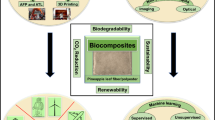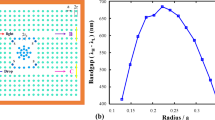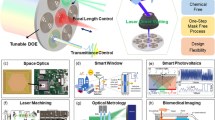Abstract
For the first time, corrosion sensors are designed by using 1D Quaternary photonic crystals (QPCs). These quaternary PCs have 6 periods of four material layers followed by a defect layer (of air) then again 6 periods of same four material layers combination. These 1D quaternary PC-based corrosion sensors are highly sensitive. The corrosion sensitive output spectra transmission peak shifts of first and second 1D QPCs containing defect layers are 11 and 10 nm, respectively, over the displacement range of 0.1–0.4 µm. These quaternary PC-based corrosion sensors can be used to detect corrosion in reinforced concrete structures for monitoring civil engineering structures.




Similar content being viewed by others
References
S. Ahmad, Reinforcement corrosion in concrete structures, its monitoring and service life prediction—a review. Cement Concr. Compos. 25, 459–471 (2003)
H.W. Song, V. Saraswathy, Corrosion monitoring of reinforced concrete structures—a review. Int. J. Electrochem. Sci. 2, 1–28 (2007)
B. Elsener, C. Andrade, J. Gulikers, R. Polder, M. Raupach, Half-cell potential measurements—potential mapping on reinforced concrete structures. Mater. Struct. 36, 461–471 (2003)
R.B. Polder, Test methods for on site measurement of resistivity of concrete—A RILEM TC-154 technical recommendation. Constr. Build. Mater. 15, 125–131 (2001)
C. Andrade, J.A. Gonzalez, Quantitative measurements of corrosion rate of reinforcing steels embedded in concrete using polarization resistance measurements. Werkst. Korros. 29, 515–519 (1978)
J. Xu, W. Yao, Corrosion detection of steel in concrete by use of galvanostatic pulse technique. J. Chin. Soci. Corros. Prot. 30, 181–186 (2010)
T. Fukuyama, H. Nagai, T. Noguchi, Corrosion monitoring of reinforcing bars by electrochemical noise measurement, in Proceeding of the 4th International Conference on Structural Health Monitoring of Intelligent Infrastructure (SHMII-4), Zurich, Switzerland, 22–24 July 2009
J. Swarup, P.C. Sharma, Electrochemical techniques for the monitoring of corrosion of reinforcement in concrete structures. Bull. Electrochem. 12, 103–108 (1996)
B. Elsener, H. Wojtas, H. Bohni, Inspection and monitoring of reinforced concrete structures—electrochemical methods to detect corrosion. Insight 36, 502–506 (1994)
H. Sohn, G. Park, J.R. Wait, N.P. Limback, C.R. Farrar, Wavelet-based active sensing for delamination detection in composite structures. Smart Mater. Struct. 13, 153–160 (2004)
J.H. Bungey, Ultrasonic testing to identify alkali-silica reaction in concrete. Br. J. Non-Destr. Test. 33, 227–231 (1991)
A.G. Beattie, Acoustic emission, principles and instrumentation. J.Acoustic Emiss. 2, 95–128 (1983)
M.T. Liang, P.J. Su, Detection of the corrosion damage of rebar in concrete using impact-echo method. Cem. Concr. Res. 31, 1427–1436 (2001)
S. Kabir, A. Zaki, Detection and quantification of corrosion damage using ground penetrating radar (GPR). In Proc. Prog. Electromagn. Res. Symp. (PIERS). Marrakesh, Marocco, 20–23 (2011)
C. Maierhofer, Nondestructive evaluation of concrete infrastructure with ground penetrating radar. J. Mater. Civil Eng. 15, 287–297 (2003)
M.R.A. Hassan, M.H.A. Bakar, K. Dambul, F.R.M. Adikan, Optical-based sensors for monitoring corrosion of reinforcement rebar via an etched Cladding Bragg grating. Sensors 12, 15820–15826 (2012)
Z. Zheng, X. Sun, Y. Lei, Monitoring corrosion of reinforcement in concrete structures via fiber Bragg grating sensors. Front. Mechan. Eng. 4, 316–319 (2009)
J. Gao, J. Wu, J. Li, X. Zhao, Monitoring of corrosion in reinforced concrete structure using Bragg grating sensing. NDT & E Int. 44, 202–205 (2011)
K.T. Lau, Fibre-optic sensors and smart composites for concrete applications. Mag. Concr. Res. 55, 19–34 (2003)
J. Geng, J. Wu, X. Zhao, Simulation of fiber Bragg grating sensor for rebar corrosion. In Proc. SPIE—Int. Soc. Opt. Eng. Weihai, China, (2009)
L. Chung, I.K. Paik, Y.S. Roh, Non-destructive evaluation techniques of reinforcing steel corrosion using infrared thermography. Key Eng. Mater. 270, 1592–1597 (2004)
L. Chung, I.K. Paik, S.H. Cho, Y.S. Roh, Infrared thermographic technique to measure corrosion in reinforcing bar. Key Eng. Mater. 321, 821–824 (2006)
M.M. Abadla, N.A. Tabaza, W. Tabaza, N.R. Ramanujam, K.S.J. Wilson, D. Vigneswaran, S.A. Taya, Properties of ternary photonic crystal consisting of dielectric/plasma/ dielectric as a lattice period. Optik 185, 784–793 (2019)
D.M. El-Amassi, S.A. Taya, D. Vigneswaran, Temperature sensor utilizing a ternary photonic crystal with a polymer layer sandwiched between Si and SiO2 layers. J.Theor. Appl. Phy. 12, 293–298 (2018)
S.A. Taya, Ternary photonic crystal with left-handed material layer for refractometric application. Opto-Electron. Rev. 26, 236–241 (2018)
K.M. Abohassan, H.S. Ashour, M.M. Abadla, One-dimensional ZnSe/ZnS/BK7 ternary planar photonic crystals as wide angle infrared reflectors. Results Phys. 22, 103882 (2021)
R. Talebzadeh, M. Bavaghar, Tunable defect mode in one-dimensional ternary nanophotonic crystal with mirror symmetry. J. Optoelectron. Nanostruct. 2, 83–92 (2017)
D.M. El-Amassi, S.A. Taya, N.R. Ramanujam, D. Vigneswaran, R. Udaiyakumar, Extension of energy band gap in ternary photonic crystal using left-handed materials. Superlattices Microstruct. 120, 353–362 (2018)
A. Banerjee, Enhanced incidence angle based spectrum tuning by using one-dimensional ternary photonic band gap structures. J. Electromagn. Waves Appl. 24, 1023–1032 (2010)
A. Banerjee, Enhanced temperature sensing by using one-dimensional ternary photonic band gap structures. Progress Electromagn. Res. Lett. 11, 129–137 (2009)
A. Banerjee, Enhanced refractometric optical sensing by using one-dimensional ternary photonic crystals. Progress Electromagn. Res. 89, 11–22 (2009)
A. Banerjee, Enhancement in sensitivity of blood glucose sensor by using 1D defect ternary photonic band gap structures. J. Opt. 48, 262–265 (2019)
A. Banerjee, Design of enhanced sensitivity gas sensors by using 1D defect ternary photonic band gap structures. Indian J. Phys. 94, 535–539 (2020)
A. Banerjee, Novel applications of one-dimensional photonic crystal in optical buffering and optical time division multiplexing. Optik Int. J. Light Electron Opt. 122, 355–357 (2011)
A. Banerjee, Binary number sequence multilayer structure based refractometric optical sensing element. J. Electromagn. Waves Appl. 22, 2439–2449 (2008)
A. Banerjee, Design of narrowband optical filters using binary number sequence photonic crystals. Int. J. Infrared Millimeter Waves 29, 1070–1082 (2008)
A. Banerjee, Testing multilayer structures for optical filtering in temperature unstable environments. Optik 126, 3728–3730 (2015)
A. Banerjee, S. Rizvi, Suitability of 1D photonic band gap structures for electrical tuning of transmission spectrum. In Opt. Filters 2018 Int. Conf. Comput. Charact. Tech. Eng. & Sci. (CCTES), 272–275 (2018).
A. Banerjee, Design of Beam Splitters by Using 1D Defect Ternary Photonic Band Gap Structures. In Proc. Fifth Int. Conf. Inventive Mater. Sci. Appl. 27–32 (2023).
A. Banerjee, U. Malaviya, Design of a tunable ultraviolet filter using metallodielectric photonic crystal. In 2007 IEEE Appl. Electromagn. Conf. (AEMC). 1–4 (2007)
A. Banerjee, Design of a multiwavelength optical buffer for optical networks by using a 1D defect ternary photonic multilayer structures. J. Opt. (2022). https://doi.org/10.1007/s12596-022-00992-z
A. Banerjee, A note on “Variable-focus liquid lens based on electrically responsive fluid”. J. Opt. (2022). https://doi.org/10.1007/s12596-022-01013-9
Z.A. Zaky, A. Sharma, S. Alamri et al., Detection of fat concentration in milk using ternary photonic crystal. Silicon 14, 6063–6073 (2022)
Author information
Authors and Affiliations
Corresponding author
Additional information
Publisher's Note
Springer Nature remains neutral with regard to jurisdictional claims in published maps and institutional affiliations.
Rights and permissions
Springer Nature or its licensor (e.g. a society or other partner) holds exclusive rights to this article under a publishing agreement with the author(s) or other rightsholder(s); author self-archiving of the accepted manuscript version of this article is solely governed by the terms of such publishing agreement and applicable law.
About this article
Cite this article
Singh, A.K., Kulshreshtha, A. & Banerjee, A. Design of corrosion sensors by using 1D quaternary photonic crystal with defect layer. J Opt 52, 1919–1924 (2023). https://doi.org/10.1007/s12596-022-01085-7
Received:
Accepted:
Published:
Issue Date:
DOI: https://doi.org/10.1007/s12596-022-01085-7




